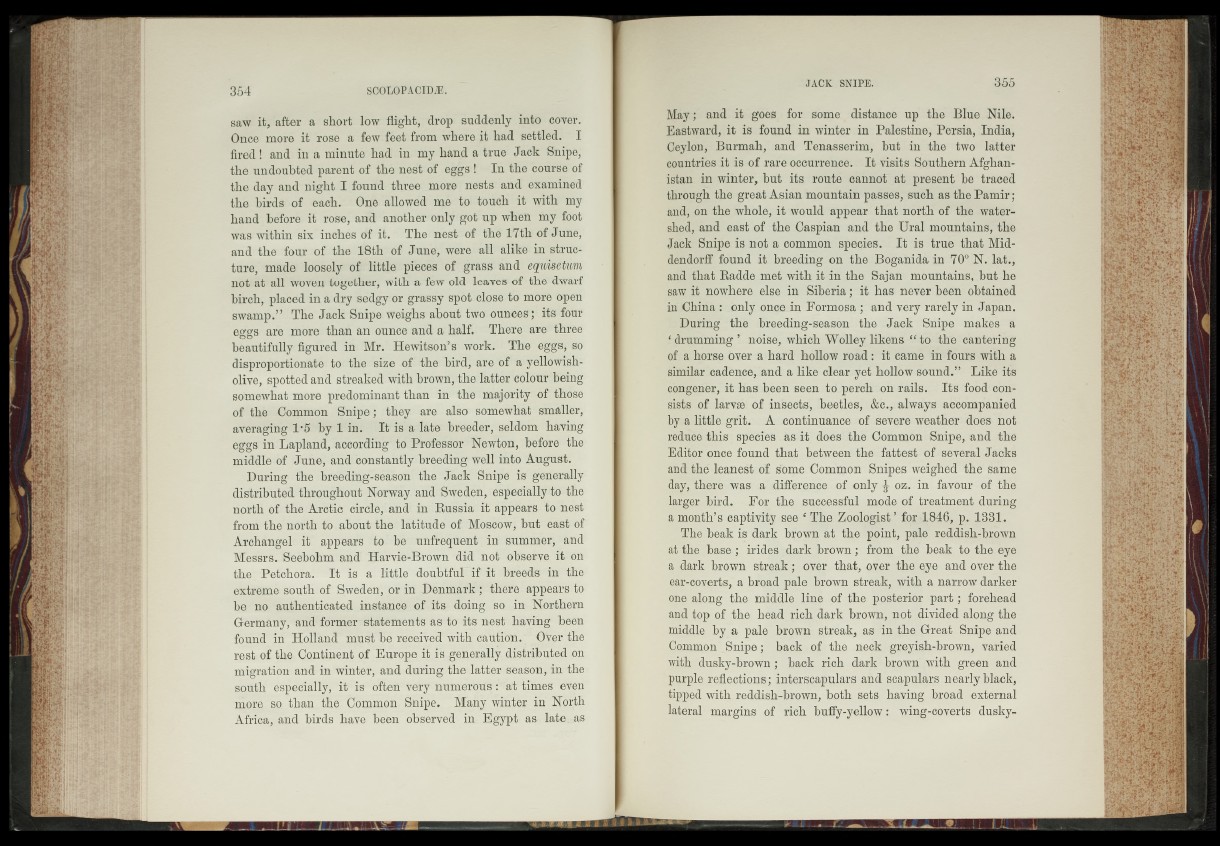
saw it, after a short low flight, drop suddenly into cover.
Once more it rose a few feet from where it had settled. I
fired ! and iir a minute had sin- my hand a true Jack Snipe,'
the undoubted parent of the nest of eggs !' -In-the course of
the day and night I foutfd three ; more nests and examined
the birds of each. One allowed me to- touch it' withrmy
hand béfore it rose, and another only got up when my foot
was within six inches df it. The nestr:of the lTthof June,
and the four of the 18th of June,- were j |g | alike-in structure,
made loosely of little pieces “of grass and equisêtüm
not at all woven together, with a few old leaves of the dwarf
birch, placed in a dry sedgy or grassy spot-close to more epen
swamp.” The Jack Snipe weighs about two ounce sgi itsdour
eggs are more than an ounce and a'half.- There are^three
beautifully figured in Mr: HewitsbnJ’S' work: ■ Th'e eggs, to
disproportionate ’ tö' the'sïbê .of the bird, are of a yellowish-
olive, spotted and streaked with brown; the latter colotÉrvtóng
somewhat more predominant than in the majority-' of* those
of the Common Snipe; they are also somewhat smaller,
averaging 1 •5"'by 1 in. It is a latesbreeder, seldom having
eggs in Lapland, according* to” Professor I Slewton,' before- the
middle of Juüe, and: constantly breeding* well into August'.
During the breeding-seasonr the.' Jack Snipe is generally
distributed throughout Horway aild^Sweden, especiallyfto- the
north of the Arctic' circle,'and in Eussia: it appears-tomest
from ?the. north to about the- latitude ’oft rMoscfow; bufeehst^
Archangel it. appears “tonbe unfrequTent^fih summer; and
Messrs./Seébohm and: H-arvie-Brown did noi observe ilbln
the Petchora; " I t is a ”little' dohtófuffif it "breed's in "the
extreme south-.ofe Sweden,jjnyin DenmailJ^S^^J appears !to>
he-no authenticated instance* of its*-d'oingrIsQ, in Northern
Gter-many^ andr former- statements* 'asdo'dts nest having been
föuifd’ inTl^|3%iJ^ must b with ƒ ; '^öycrtpé
rest of the. Cpntinent otTEurope it is generally, di^tiibute^ pn
migration-and-in winter; and during the datierss'eason; in thei
south espéeiMl^4l^'sK%ft^^^y^umerön§ : tfkt" times even
morapSk than the Common" Shipe. ' ]^any winter h h k
Africa/and birds have heen ohsmvid ir^/Egy-pt asrletS&ajS
May; and it goes for some distance up the Blue Nile.
Eastward, it is found in winter in Palestine, Persia, India,
Ceylon, Burmah, and Tenasserim, but in the two latter
countries it is of rare occurrence. It visits Southern Afghanistan
in winter, but its route cannof at present be traced
through the great Asian mountain passes, such as the Pamir ;
and, on the whole, it would appear that north of the watershed,
and east of the Caspian and the Ural mountains, the
Jack Snipe is hot a common species.' - It is true that Mid-
dendorff found it breeding on the Boganida in.70$|N.: lat.,
and that Eadde met with it in the Sajan mountains, but he
saw it nowhere else in Siberia; it has never been obtained
in iChiha : only once_in Formosa ; and very rarely in Japan.
. During the .breeding-season the .Jack Snipe makes a
i drumming ’ noise, which Wolley likens -to the cantering
of; a horse óver a hard hollow road; it e&më in fours with a
similar cadence, and a like cleariyef "hollow sound.” Like its
congener, it has been seen to perch .oh rails. Its fobd-consists
of larvae, of insects, .'beetle's, &c., always?, accompanied
by a little grit. A continuance of severe weather* 'doe's not
reduce this- species as it does tbe Common Snipe, and the
Editor ogee found that between'the fattest of several,Jacks
and the leanest of; sbrne Common Snipes weighed the 'same
dayrthere was a^differencet Jb£ only in favour of thM
larger bird. For, tbe successful mode of treatment during
a ^month’s captivity see ‘ The Zoologist ’ for *1846, p. f3,31.
^#he beak is dark brown m rhe point, pale reddish-brown
at tbe base; indi f ^ a rk brown; from the beak to the eye
a .dark brown streak; over, that, over the eye and over tho
dlB^overts. a broad pale brown streak, with a narrow darker
one along the middle line of the posterior p a rt; forehead
an||‘t|>p of the. head^rjgH dark brow®ljnot divided along the
middle by^a pale brown :gtreak, as in-fhe fir eat Snipe and
-^.ekx:mon /Snipe; back of .peekj .gneyjsh-brqwn, varied
vjth dusky-brown^ back rich dark^hrpw^with green and
purple reflections; interscapularS and.’gpapnlars nearly black,
tipped with? Véddiap-brown, both sets having broad oxternal
lateral margins of rich buffy-yellow •' %ing-eo,verts dusky